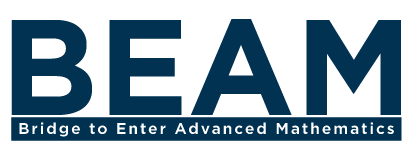BEAM is currently hiring summer faculty for Summer 2022. If you are interested in working at one of our programs, please apply here.
BEAM’s summer staff members are what make our summer programs special. Knowing how much we get from our staff, we recently asked some of our long-time Summer Away faculty what they’ve gotten from working with us. The answers we got were resoundingly encouraging.
What we consistently heard was that our faculty learn from our students just as our students learn from them. Our staff learn how to be flexible, how to connect with students in a way that makes them more excited about math, and how to bring the spirit of mathematical exploration and discovery back to their year-round jobs. Here’s what our faculty have to say:
Tanya Finkelstein
For Tanya, one of the most special things about BEAM students is how much they can figure out on their own. With only a definition, they can really run! Of course, letting students run requires curricular flexibility and a willingness to be confused that most teachers are taught not to have. It’s a learning experience:
“The most important way you’ll grow as a BSA faculty is learning not to have expectations, which so many teachers come in with. Teachers are taught to have expectations of themselves that they’ll always have the answers and know how to guide their students to the solution. The most important thing kids need from you is to guide them along their own path to the answer without an expectation of what that path will look like. Some of the best teachers I’ve had in my life were kids. A teacher should be ready to feel challenged. It’s important to be confused yourself and make sense of things in front of the students so they can see a model of exploration. This is how you grow over time with BEAM.” – Tanya Finkelstein
Siddhi Krishna
Siddhi has taught both Cryptography and Knot Theory every year she’s been with us, but her classes have never looked the same twice. Siddhi attributes this to the fact that the direction the class goes depends on what the students are buzzing about any one summer. Bringing the exploratory culture of BEAM classrooms to her year-round teaching has ultimately translated to better outcomes for her year-round students. In her own words:
“I’ve learned how to listen much more closely to what students are saying. I’ve also learned to ask better questions. When a student says something, you want to draw the best thing out of them without telling them the answers. What BEAM does well is create a culture where students aren’t expected to know the answers. Trying to inject that spirit into my teaching at the university level has been important. Making it clear I don’t expect you to know the answers, but I do expect you to ask questions and try to bridge that gap, has made a difference in what my students get out of my college classes.” – Siddhi Krishna
Andre Mathurin
For Andre, teaching with BEAM was a stark contrast to the formulaic, almost sterile culture of mathematics education that exists in most high schools. Being able to think about big concepts and problems without the overhead of midterms or standardized exams was not only personally motivating for Andre, it also helped him learn to better connect with students in his year-round position.
“My first summer I had this idea that it would be super structured. I realized that you can have a game plan and that’s fine, but the need to be flexible and meet students where they are is important. That’s one of the big learnings I got from BEAM, how to leverage students by getting them to work together and make it about discovering math versus me being the one to point things out to them. One of the incredible things about BEAM students is that they really can do this. They leave the summer program being better thinkers and better communicators.” – Andre Mathurin
Cory Colbert
Cory has worked with BEAM every summer since 2014, and he’s taught topics ranging from Analytic Number Theory to Aviation Theory. Working with BEAM has not only given Cory the same tools for leading a discovery and exploration-based classroom as other staff, it’s given him a vehicle to reflect on how he thinks about equity in STEM more broadly:
“I used to not think very explicitly about equity, diversity and inclusion, especially in 2014. I think I had gotten so used to being the only Black person in a classroom (or one of the only), and one of only 2 Black graduate students in math at my school (out of over 100), that I think I grew numb to how much STEM struggles with diversity… Recently, with regards to teaching, my focus has been on combating bias and micro-aggressions in the classroom. For example, my women students are less likely to volunteer an answer than their male counterparts. So, I'll make extra efforts to encourage women to share their results with the class, which are usually right, by the way... My hope is that maybe BEAM faculty can learn how to be effective anti-racist teachers both at BEAM and elsewhere.” – Cory Colbert
BEAM is currently hiring summer faculty for Summer 2022. If you are interested in working at one of our programs, please apply here.




